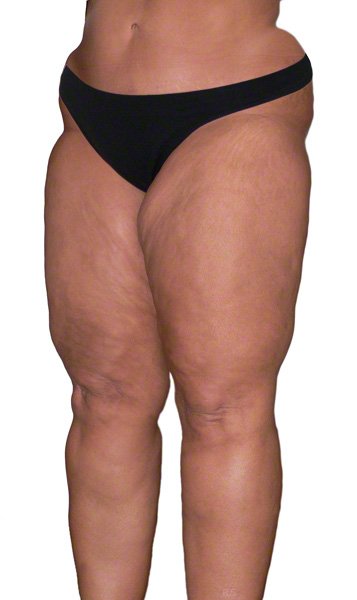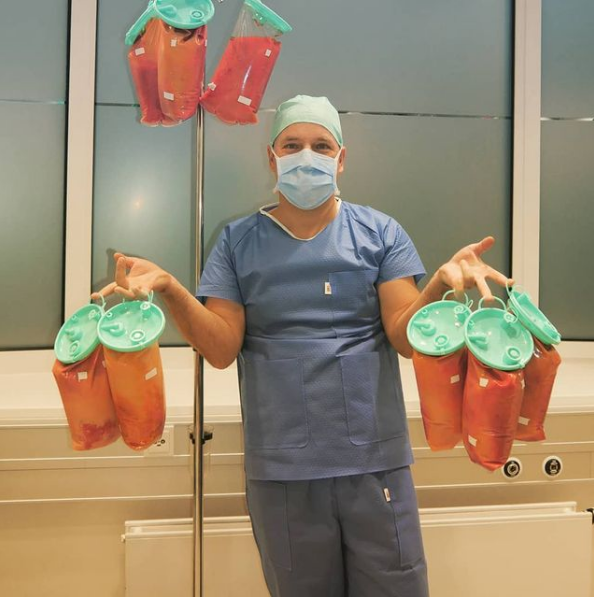On this page you can find out more about lipoedema liposuction at the Yuveo Clinic in Düsseldorf. It is the only method that can achieve long-term treatment success for a fat distribution disorder.
This disease can affect women who are overweight as well as athletic and slim women. Men suffer from it much less frequently if they have specific hormonal disorders.
If non-surgical treatments have been exhausted and the symptoms of the mostly affected women cannot be reduced any further, liposuction may be the right strategy.
In general, larger amounts of fat tissue need to be suctioned out, mainly in the legs, especially in the advanced stages of lipoedema. However, the arms, hips and buttocks can also be affected.
Liposuction of this kind is only offered by a few specialists. Your plastic surgeons Dr. Schumann and Dr. Schumann-Averkiou have many years of experience with such procedures, and the entire Düsseldorf team is trained to perform them. Our expert anesthesia team at the Yuveo Clinic in Düsseldorf guarantees gentle anesthesia during lipedema surgery.
Yuveo Clinic
Special features of lipoedema liposuction
It is the only method that can achieve long-term treatment success for a fat distribution disorder.
Rest and compression after surgery
Lipedema treatment
Liposuction for lipoedema means liposuction: this is now an established method. However, before you decide to have this operation, we recommend that you exhaust the conservative treatment options. It is also important to rule out other causes of increased circumference, such as lymphoedema or oedema caused by internal diseases, which are indicated by their specific symptoms.
Liposuction for a better quality of life
Liposuction drastically reduces the amount of fatty tissue affected by lipoedema on the arms and legs (or hips and bottom), which is accompanied by a significant reduction in both physical and psychological discomfort. Our patients benefit in particular from the reduced tendency to swell and the reduction in pain. This can significantly improve patients’ quality of life.
Modern and gentle surgical method
In principle, the procedure for lipoedema is performed in the same way as described in the liposuction article. A popular procedure is PAL (power-assisted liposuction), which uses micro-vibrations to ensure better tissue protection. In other words, it could also be said that more fatty tissue can be suctioned out of the lipoedema than with the conventional technique due to the tissue protection.
Suction volumes vary greatly
The volumes that are suctioned depend on the symptoms of the women and the stage of lipoedema. While a few liters are sufficient in the early stages, advanced stages involve so-called mega liposuction with a volume of up to over 10 liters.

Frequently asked questions about lipoedema treatment
Conservative therapy without surgery can be briefly summarized as follows:
- Diet: take measures against obesity! Increased food intake worsens the findings. Even after dieting, however, there is a disproportion in the body proportions of the women mostly affected.
- Decongestion treatment:
- Manual lymphatic drainage
- Compression treatment using compression bandages and compression garments (compression pants, support corsetry) that exert pressure on the tissue.
- If necessary, pneumatic decompression (pants that can be inflated with air reduce water retention – edema – in the legs through pressure)
Unfortunately, these treatment measures for lipoedema are often only of a temporary nature and must be repeated at certain intervals. It is therefore not possible to achieve a reduction in the fatty tissue of the diseased tissue. Women’s complaints cannot be permanently managed in this way. This only works in the context of lipoedema liposuction.
Liposuction is particularly useful if the non-surgical treatment options do not lead to the desired results and the symptoms cannot be permanently reduced.
Pain that can no longer be treated can often be reduced by suction.
Furthermore, the aesthetic disproportion of the body proportions and the associated psychological suffering of the patients are often the reason for the decision to have liposuction.
Nevertheless, any contraindications should be taken into consideration. These can include the following: serious secondary illnesses such as cardiac insufficiency, some cardiac arrhythmias, severe varicose veins, blood clotting disorders and many more.
The estimated extent of the lipoedema treatment should also be taken into account with regard to the resulting excess skin. When suctioning larger volumes (over 8-10 liters), you must expect that shrinkage will only occur to a reduced extent, depending on the skin quality. We would also like to point out that a subsequent thigh lift may be necessary if there is a lot of excess skin on the thighs.
We cannot give a general answer to this, as it depends on the stage of the lipoedema and the extent of the liposuction. Individual factors also play a role. The sensation of pain varies greatly, as does the stabilization of the circulation during major procedures. The areas treated and the structure of the tissue also play an important role. In the case of minor procedures, you may be able to return to work after just one week. For large liposuctions of 10 or more liters due to an advanced stage of the disease, you will certainly have to allow 2-3 weeks, depending on what activity you are doing.
Due to the fat distribution disorder, the lymphatic system that runs through our body can be restricted in its function. The lymph cannot drain optimally and this can lead to fluid accumulation in the tissues. Lipoedema can therefore actually trigger lymphoedema.
One challenge is distinguishing lipedema from obesity and overweight, which are caused in particular by a lack of exercise and a poor diet.
The follow-up treatment depends on the severity of the lipoedema before the operation and the extent of the procedure. Decongestive treatment over a period of several weeks to a few months is very important, as there are often enormous amounts of tissue that are removed. These have a corresponding tendency to swell after the operation. Rest and elevation of the legs are just as important. The stitches at the puncture sites can usually be removed after 5 to 7 days in our clinic in Düsseldorf.
It can take several months for the final results to become visible after liposuction on the arms, legs, hips or buttocks.
The excess skin that can occur after extensive surgery is assessed and we discuss with our patients whether additional skin tightening should be performed.
You need to calculate the cost of liposuction for lipoedema in a similar way to normal liposuction. Most plastic surgeons in Germany make the price dependent on the quantity and localization of the areas to be treated. Logically, lower prices are also charged for smaller liposuction procedures with smaller volumes. In the case of extreme findings, you should expect relatively higher costs. There are also additional costs for anesthesia. Some plastic surgeons also charge a fee for an overnight stay in hospital after liposuction.
When calculating the costs, the number of sessions in which the lipoedema surgery is planned often plays a role. In general, it can be assumed that many small sessions are significantly more expensive than one large operation.
Although lipoedema is a disease, most health insurance companies do not cover the costs of liposuction. It is therefore a self-pay service. The measures, which do not require surgery, range from activating the lymphatic system using special grip techniques to decongesting the affected areas of the body using pressure (compression treatment). They are covered by health insurance and lipoedema is therefore recognized as a disease. If you are unsure, please ask your statutory health insurance provider.
Facts about lipoedema treatment
- Practitioners: Dr. Schumann and Dr. Schumann-Averkiou
- Treatment duration:
about up to 3 hours - Anesthesia:
local anesthesia with twilight sleep, general anesthesia - Hospitalization:
outpatient or inpatient - Follow-up treatment:
Compression: for several weeks to months, elevate legs, rest - Remove stitches:
after about 5 to 7 days - Sport:
Time out for about 6 weeks - Costs: on request
Further information and related topics
- Liposuction
- Information on nutrition, exercise and advice for lipedema
- Lipomatosis, which also includes lipedema, is a disease associated with a fat distribution disorder in which multiple (many) lipomas or a lipoma-like accumulation of fatty tissue is found in certain regions.
- Lipomas are isolated and asymmetrical fatty tumors.
- Stages of lipedema
- Symptoms of fat distribution disorder
- Causes of lipedema
- What is lipedema?


